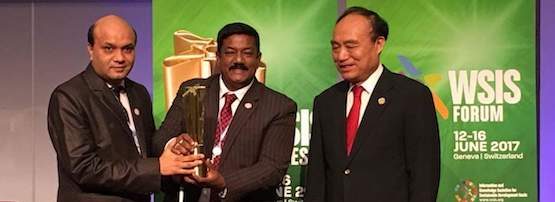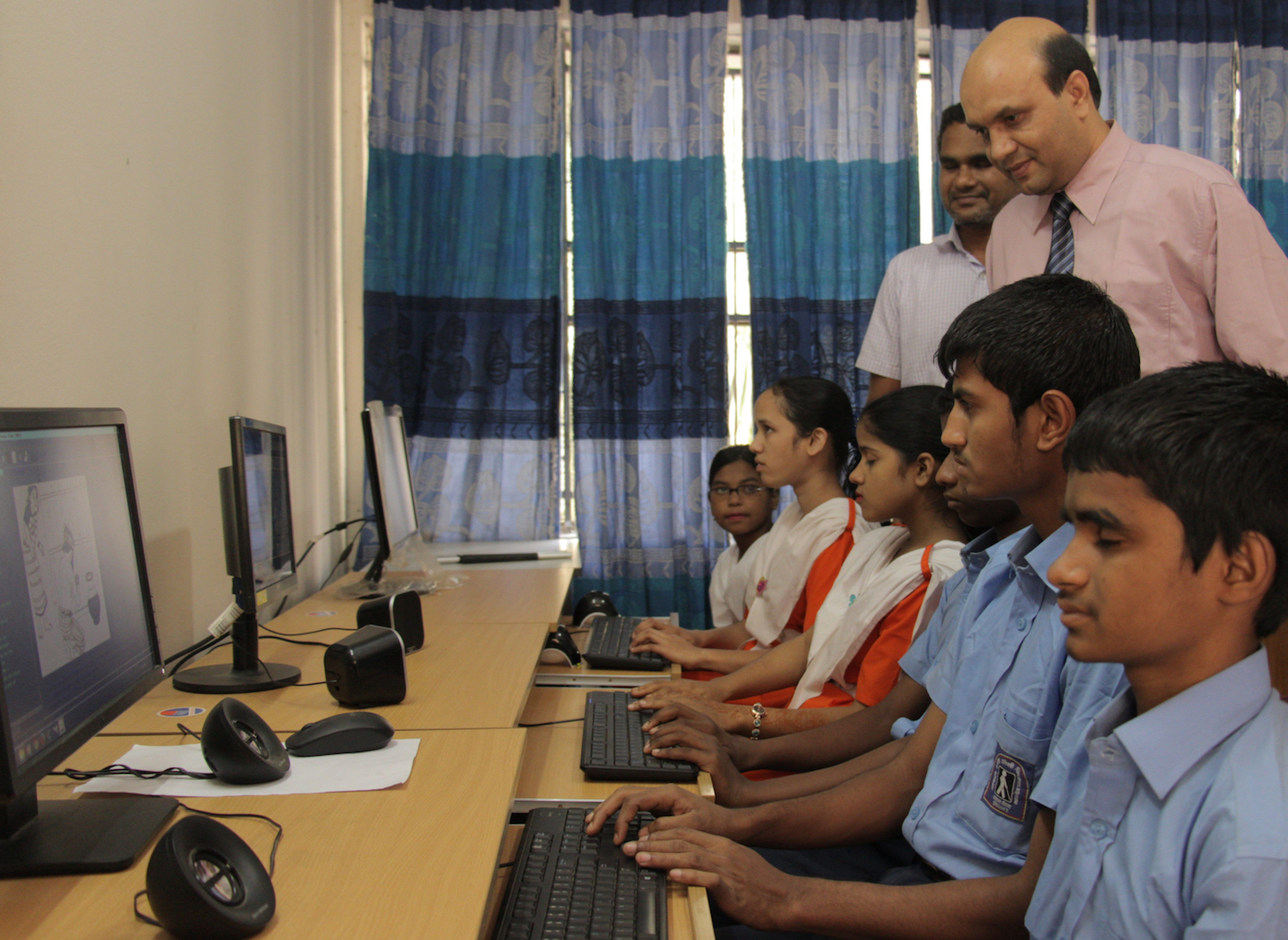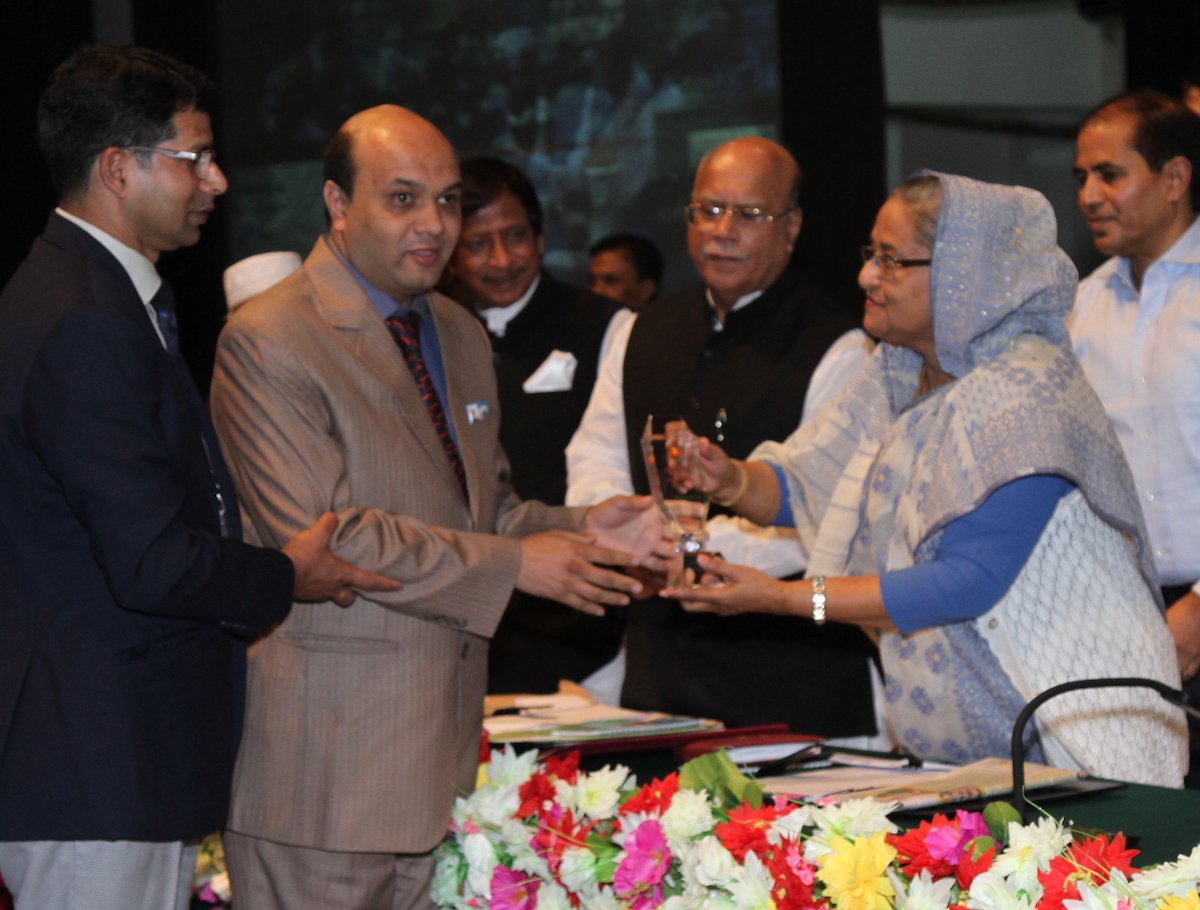
Bangladesh has again won one of the world’s most prestigious IT awards when it was awarded a World Summit on the Information Society (WSIS) Prize by the United Nation’s International Telecommunication Union (ITU) in Geneva in June.
Winning the award for Bangladesh this year was a project titled ‘DAISY-standard Accessible Reading Materials for Persons with Visual Disabilities’, which was headed by former APNIC Fellow and ISIF Award recipient Vashkar Bhattacharjee, who is himself visually impaired.
Bhattacharjee is part of the Access to Information (a2i) Program of the Prime Minister’s Office of Bangladesh, and, backed by a2i’s Service Innovation Fund and, with help from the Young Power in Social Action (YPSA) organization, a2i transformed regular textbooks into user-friendly ‘DAISY Multimedia Books’ for all subjects from Classes 1 to 10.
Bhattacharjee shares his story of how ICT has empowered one blind person to make the world accessible for others …
The year was 1979. Bangladesh was still recovering from the horrors of the liberation war, which took away more than three million lives in a matter of just nine months. The average GDP per capita was less than USD 200, while the infant mortality rate was 136 per 1,000 live births (almost 4.5 times the current average!).
Like a number of villages in Bangladesh, my village in the district of Chittagong did not have doctors and hospitals. So, on 1 July that year, I was born in my parental home without any medical supervision.
I found out 15 years later, that right after my birth, I was bleeding through my nose and mouth. My parents and relatives could not figure out what was wrong. After a while, the bleeding stopped and everything seemed to be normal. By the time I was two years old, my parents realized that I had gone blind.
Countries that have successfully climbed up the development ladder consider disability to be not “absence of ability”, but more a case of “having special ability”. Studies have shown that people who became blind at an early age can hear better than people who are able to see. A number of private sector organizations have realized this special ability of people with visual disabilities and have even gone on to a selective employment strategy.
In Bangladesh, even until the end of the previous millennium, the situation was quite the reverse. While education was supposed to be a basic right for every citizen, it used to be considered a luxury for children with visual disabilities in Bangladesh, even more so in rural Bangladesh. My parents deliberated long and hard about whether they wanted me to have an education, along with all the other children of my village.
Others questioned why I should be going to school, since the thinking was that people who cannot see are a burden on society — unable to perform any tasks on their own and always looking for charity. My father, a government employee, soon came to hear about a primary school for the blind, where I was soon admitted.
Text books in Braille were rarely available, and schools also rarely had writing frames or Braille paper. As a result, I was considered a freak of nature when I managed to complete the Higher Secondary Certificate (HSC) exam and got into a university, while most of my primary school buddies had dropped from school after completing secondary school.
At university, the journey got much more difficult, since I had to compete with students who could see and who did not require the teacher to read out the lessons. I was truly grateful for some classmates who helped me take down notes and prepare for exams. But the exams were another hurdle: I had to convince my teachers to provide me with an assistant during exams who would listen to my answers and write them down on paper.
It was these experiences that made me think more deeply about the need for accessible education and shaped my life in a great way. With great support from my teachers and fellow students, I graduated with honours in history from Chittagong University and obtained a Master’s degree in General History.
But now it was time to start looking for a job and earn my own living. It was then that I realized how bad the situation was for blind persons, whom no one will hire for fear of their presumed lack of productivity. As a result, I was unemployed for a few months and had to learn the hard way that theoretical learning alone would not be enough — I needed to be technologically skilled as well.
Leading and helping the visually impaired
It was during this difficult time that I was blessed to win a place in the fourth Duskin Leadership Training in Japan, a program for persons with disabilities in Asia and the Pacific. From August 2002 to July 2003, I was trained on the application of Computer & Information Technology for Persons with Visual Impairment. The next year, I completed the Duskin follow-up training in Bangkok, Thailand.
This was the turning point of my life, when I understood my life’s purpose: to make services accessible through the use of ICT.
In 2006, I was introduced to the Digital Accessible Information System (DAISY) Consortium, where I came across some really amazing people who dramatically changed my perspective of the world. They trained me to become an International Trainer.
When I look back, I cannot help but be amazed. While I did not have any teacher at school trained to teach blind students, here I was, about 15 years later, teaching blind persons how to access content using the power of ICT.
After this, I did not look back. After returning to Bangladesh, I joined Young Power in Social Action (YPSA), one of the country’s leading social development organizations working on the protection of rights for persons with disabilities. As a program manager and focal point of DAISY and the IRCD (ICT and Resource Center on Disabilities) at YPSA, I had the perfect platform to experiment with various innovative techniques for getting information to the visually disabled community.
Since 2005, we have been reaching out to various user groups through Digital Talking Book technologies. These audiobooks can be heard on standalone DAISY players, computers using DAISY playback software, mobile phones, DVD and MP3 players. But the digital content was very limited and prepared to fulfil the requirements of specific development projects targeting a specialized group of beneficiaries.
YPSA saw the unique challenges facing the print-disabled population of school-going age (including 215,429 children having some difficulty with seeing and 46,105 children having severe difficulty seeing or are completely visually impaired).
These challenges include unavailability of Braille-printed books for the national curriculum, inadequate number of teachers specialized in teaching visually-impaired children, skewed focus towards a textual form of education, and so on.
As a result, most of them never get to go to school. Among the ones who do manage to, the visually-impaired students often get disappointed at having to use second-hand books and the illiterate get bored because of the limited interactivity offered by text-based content. Even though there are some Braille printing presses in the country, there was no way to develop Braille-printed books for the national curriculum textbooks because the text was encoded in formats that were not compatible with Unicode.
With its previous experience of using text-to-speech technologies for converting written materials into audible works, YPSA had to come up with a combination of technologies that could overcome the drawbacks of the previous method and ensure quality products for the final users. But YPSA had neither the resources to develop a complete prototype, nor the liaison with government bodies required to roll out the final product across the nation.
YPSA started working with the Access to Information (a2i) Program and the United Nations Development Programme in 2009 when it developed digital talking books for various articles on issues related to disaster, health, law, and livelihood. a2i, the world’s first public service Innovation Lab+, works to ensure easy, affordable and reliable access to quality public services for all citizens of Bangladesh. It drives the creation of a public service innovation ecosystem and delivery infrastructure from the Prime Minister’s Office.
One way a2i is doing so is through engaging and empowering the whole of Bangladeshi society by offering a Service Innovation Fund to co-create novel solutions to development challenges and boost their chances of making impact at scale.
YPSA applied for and received this fund to design and develop DAISY-standard accessible reading materials, popularly known as Multimedia Talking Books, for students from classes 1 to 10 that are handed over to visually impaired students every year on Textbook Day (1 January) by the Prime Minister.
Watch another video on the multimedia talking book here.
Today, around 100,000 students with a visual, print and learning disability, and also the information-disadvantaged group, can read and listen to their textbooks, which can significantly improve their learning. This has made primary and secondary education inclusive and accessible for all students, and has contributed to improving literacy and numeracy.
WSIS prize and others
For developing these multimedia talking books, YPSA had already won multiple accolades for the advancement of the accessibility of digital publications to persons with print disabilities Innovative models and practices. The most remarkable among these awards were the Accessible Books Consortium Award for Accessible Publishing Initiative at the International Excellence Award 2015 held in London Book Fair; the Information Society Innovation Fund (ISIF Asia) Award, 2014; and the Zero Projects Award on Inclusive Education (2016).
On my part, I was recognised by the Bangladesh’s Honourable Prime Minister Sheikh Hasina as a successful person with disability, for my contribution in disability and development, specially in support of the activities of disability including through ICT, digital talking books, and making the skills and technology available for people with disabilities.
a2i nominated the project for the WSIS prize, and WSIS found that it is directly related to its Action Line C3 category — Access to information and knowledge — whereby ICT allows individuals, organizations, and communities anywhere in the world to access information and knowledge almost instantaneously and benefit from it.
But it would be unwise to say that multimedia talking books on their own will solve all the problems that persons with visual disabilities face when trying to receive an education. They would still require an assistive device (called a Braille reader) when reading any book that has already been converted to digital text but lacking an audio version. Again, with an average vocabulary level, any person with a visual disability might require the assistance of an accessible dictionary. Moreover, as a blind person, I face numerous challenges when going to work every day — such as finding my way from home to the office.
I try to use all available opportunities to advance these causes in the relevant forums. Over the years, apart from being part of YPSA, I have managed to become affiliated with important organizations in different capacities: the Second Vice President of GAATES (Global Alliance on Accessible Technologies & Environments); the Convener of the National ICT thematic group of NFOWD (National Forum of Organizations Working with the Disabled) in Bangladesh; and national consultant on web accessibility for the Access to Information (a2i) Programme under the Prime Minister’s Office. I was one of the founders of the Federation of DPOs Sitakund, which is composed of 2000 people with disabilities from rural Chittagong.
Looking ahead
As a member of a2i, I am now working on an accessible dictionary (in both Bengali and English) developed by YPSA and using a2i’s Service Innovation Fund. I am also supervising a2i’s efforts on the following initiatives:
- Making the National Portal — the country’s largest government services web portal — into an all-accessible web portal;
- Making Chittagong University — one of the largest universities in Bangladesh — into Bangladesh’s first inclusive university;
- Ratifying the Marakesh Treaty by the Government of Bangladesh to allow exception of copyrights for all-accessible reading materials; and
- Solving challenges to having ePub.
Throughout my journey on the information highway, several organizations have shared with me their knowledge and resources, among them:
- WIPO, the World Intellectual Property Organization
- Accessible Books Consortium
- DAISY Consortium
- GAATES
- Disability Rights Fund
My dream project is to develop a National Library of accessible reading materials catering for all ages.
It was on my journey to receive the ISIF Award in 2013 that I got introduced to APNIC. Later, I attended the APNIC 42 conference held in Colombo, Sri Lanka, in October 2016.
APNIC’s core mandate specifically does not mention disability. But going beyond the call of duty, it has reached out to disability experts, researchers, and not-for-profit organizations who can help APNIC solve the challenges facing those with disability.
I am grateful to APNIC for advocating standards of accessibility within the IT industry. I have attended numerous conferences in my life, but APNIC 42 was the first type of corporate-driven conference where I felt important and where my views and opinions mattered. I believe that APNIC can play a leading role in implementing the United Nations Convention on the Rights of Persons with Disabilities treaty (Article 9 and 21) to ensure accessibility.
The author is National Consultant – Accessibility to the a2i Program of the Prime Minister’s Office, a Program Manager at YPSA, and Second Vice President of GAATES.
The views expressed by the authors of this blog are their own and do not necessarily reflect the views of APNIC. Please note a Code of Conduct applies to this blog.



Well-done dear Vashkar . We are really proud of you . YPSA and its all team members always with you to make accessible Bangladesh . Keep the good spirits always . In solidarity .